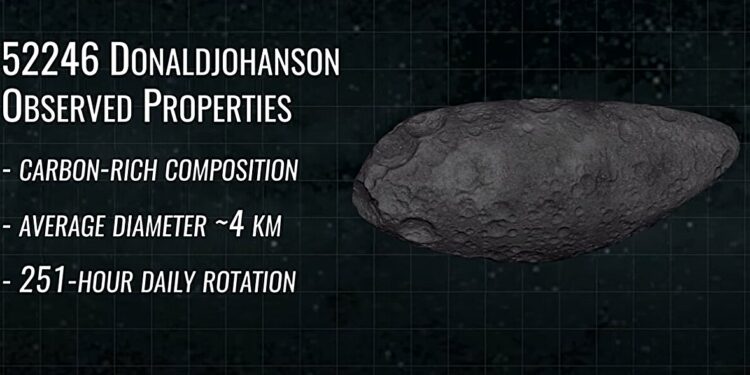Credit: NASA Goddard
Lucy Spatial de la NASA is six days and less than 50 million miles (80 million km) from its second narrow meeting with an asteroid; This time, the small asteroid of the main belt Donaldjohanson.
This upcoming event represents a complete “general rehearsal” for Lucy’s main mission during the next decade: the exploration of several Trojan asteroids who share Jupiter’s orbit around the sun. The first asteroid meeting of Lucy – an overview of the tiny asteroid of the main Dinkineh belt and its satellite, Selam, on November 1, 2023 – provided the team with an opportunity for a systems test on which they will rely during the next overflight.
The closest approach to Lucy from Donaldjohanson will perform at 1:51 p.m. HA on April 20, at a distance of 596 miles (960 km). About 30 minutes before the nearest approach, Lucy will be oriented to follow the asteroid, during which his high gain antenna will turn away from the earth, will suspect communication.
https://www.youtube.com/watch?v=ol9_0sagfbg
Guided by its terminal monitoring system, Lucy will turn independently to keep Donaldjohanson in sight. In doing so, Lucy will make a more complicated observation sequence than that used in Dinkineh. The three scientific instruments – the high -resolution gray imaging called the orri, the color imaging and the infrared spectrometer called LALPH, and the distant infrared spectrometer called the ETS – will perform observation sequences very similar to those that will occur at the asteroids of the three.
However, unlike Dinkineh, Lucy will stop following Donaldjohanson 40 seconds before the closest approach to protect her sensitive instruments against intense sunlight.
“If you were sitting on the asteroid by looking at the approach of the Lucy spacecraft, you will have to protect your eyes by looking at the sun while waiting for Lucy to be dazzled. After Lucy passes the asteroid, the positions will be reversed, so we must protect the instruments in the same way,” said the phase of Michael Vincent of Southwest Institute Institute (SWRI) Boulder, Colorad.
“These instruments are designed to photograph objects illuminated by sunlight 25 times more gradator than on the ground, so looking towards the sun could damage our cameras.”
Fortunately, this is the only seven asteroid meetings in Lucy with this difficult geometry. During the Trojan meetings, as with Dinkineh, the spacecraft will be able to collect data throughout the game.
After the nearest approach, the spacecraft “backs up”, will redirect its solar networks to the sun. About an hour later, the spacecraft will restore communication with the earth.
“One of the strange things to wrap your brain with these deep space missions is the slowness of the speed of light,” continued Vincent. “Lucy is 12.5 light minutes from the earth, which means that it takes as much time for any signal as we send to reach the spacecraft. Then, we still need 12.5 minutes before we get Lucy’s response, telling ourselves that we were heard. So, when we pass the data reading after the nearest approach, we need 25 minutes from when we ask to see the images.”
Once the health of the spacecraft has been confirmed, the engineers will order Lucy to transmit the scientific data of the meeting on Earth, which is a process that will take several days.
Donaldjohanson is a fragment of a collision 150 million years ago, making it one of the youngest asteroids in the main belt ever visited by a spacecraft.
“Each asteroid has a different story to tell, and these stories are forged to paint the history of our solar system,” said Tom Statler, scientist of the Lucy mission program at the NASA headquarters in Washington. “The fact that each new asteroid that we visit eliminates our socks means that we only start to understand the depth and richness of this story. Telescopic observations alludes that Donaldjohanson will have an interesting story, and I am fully surprised – again.”
Quote: Lucy spacecraft is preparing for the second asteroid meeting (2025, April 14) recovered on April 15, 2025 from
This document is subject to copyright. In addition to any fair program for private or research purposes, no part can be reproduced without written authorization. The content is provided only for information purposes.



